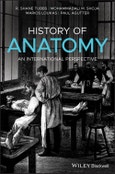Knowledge of human anatomy has not always been an essential component of medical education and practice. Most European medical schools did not emphasize anatomy in their curricula until the post-Renaissance era; current knowledge was largely produced between the 16th and 20th centuries. Although not all cultures throughout history have viewed anatomy as fundamental to medicine, most have formed ideas about the internal and external mechanisms of the body?influences on the field of anatomy that are often overlooked by scholars and practitioners of Western medicine.
History of Anatomy: An International Perspective explores the global and ancient origins of our modern-day understanding of anatomy, presenting detailed biographies of anatomists from varied cultural and historical settings. Chapters organized by geographic region, including Africa, the Middle East, and Europe, review the lives of those that helped shape our current understanding of the human form. Examining both celebrated and lesser-known figures, this comprehensive work examines their contributions to the discipline and helps readers develop a global perspective on a cornerstone of modern medicine and surgery.
- Offers a comprehensive and multidisciplinary examination of the history of anatomy
- Traces the emergence of modern knowledge of anatomy from ancient roots to the modern era
- Fills a gap in current literature on global perspectives on the history of anatomy
- Written by an internationally recognized team of practicing physicians and scholars
History of Anatomy: An International Perspective is an engaging and insightful historical review written for anatomists, anthropologists, physicians, surgeons, medical personnel, medical students, health related professionals, historians, and anyone interested in the history of anatomy, surgery, and medicine.
Table of Contents
Preface xi
Acknowledgments xiii
1 Africa 1
1.1 Egypt 2
1.1.1 The Edwin Smith Papyrus 2
1.1.2 The Ebers Papyrus 2
1.1.3 The Kahun Papyrus 3
1.1.4 Egyptian Anatomy in General 3
1.1.5 Neurological Anatomy 4
1.1.6 Cardiovascular Anatomy 6
1.1.7 Reproductive Anatomy 6
1.2 Algeria 7
1.2.1 Jean Baptiste Paulin Trolard 7
Bibliography 11
2 Asia 13
2.1 China 13
2.1.1 Correcting the Errors in the Forest of Medicine 14
2.1.2 Hua Tuo 17
2.1.3 Conclusion 19
2.2 Japan 19
2.2.1 Feudal Japan (1186-1868) 19
2.2.2 Shinnin Kawaguchi 23
2.2.3 Genpaku Sugita 24
2.2.4 Ryotaku Maeno 25
2.2.5 Shoteki Fuseya 27
2.2.6 Otsuki Gentaku 27
2.2.7 Koji Harada and Ryoetsu Hoshino 28
2.2.8 Human Dissection 28
2.2.9 Seishu Hanaoka 29
2.2.10 Buntaro Adachi 31
2.2.11 Sunao Tawara 36
2.3 India 39
2.3.1 Sushruta 39
Bibliography 44
3 Europe 49
3.1 Austria 50
3.1.1 Heinrich Obersteiner 50
3.1.2 Emil Zuckerkandl 55
3.2 Czechoslovakia 59
3.2.1 Vincent Alexander Bochdalek 59
3.3 England 62
3.3.1 Richard Lower 63
3.3.2 John Browne 71
3.3.3 James Drake 75
3.3.4 Francis Sibson 81
3.3.5 William Turner 87
3.4 France 90
3.4.1 Jacobus Sylvius 90
3.4.2 Charles Estienne 94
3.4.3 Raymond de Vieussens 96
3.4.4 Pierre Dionis 98
3.4.5 Félix Vicq d’Azyr 101
3.4.6 Marie‐François Xavier Bichat 105
3.4.7 François Magendie 109
3.4.8 Jules Germain Cloquet 114
3.4.9 Augusta Déjerine‐Klumpke 120
3.5 Germany 122
3.5.1 Adam Christian Thebesius 122
3.5.2 Franz Kaspar Hesselbach 125
3.5.3 Hubert von Luschka 128
3.5.4 Adolf Wallenberg 132
3.5.5 Korbinian Brodmann 135
3.6 Greece 141
3.6.1 Aristotle 141
3.6.2 Galen 145
3.6.3 Polybus 147
3.7 Holland 148
3.7.1 Franciscus Sylvius 149
3.7.2 Niels Stensen 150
3.7.3 Pieter Camper 154
3.8 Ireland 160
3.8.1 Abraham Colles 160
3.9 Italy 164
3.9.1 Leonardo da Vinci 165
3.9.2 Vidus Vidius (Guido Guidi) 167
3.9.3 Giambattista Canano 170
3.9.4 Matteo Realdo Colombo 172
3.9.5 Costanzo Varolio (Constantius Varolius) 174
3.9.6 Giulio Cesare Casseri 176
3.9.7 Giovanni Maria Lancisi 180
3.9.8 Giovanni Battista Morgagni 188
3.9.9 Ruggero Ferdinando Antonio Guiseppe Vincenzo Oddi 192
3.10 Norway 196
3.10.1 Johan Georg Ræder 196
3.11 Scotland 200
3.11.1 Andrew Fyfe the Elder 200
3.11.2 Sir John Struthers 204
3.11.3 Charles Bell 208
3.12 Spain 213
3.12.1 Antonio de Gimbernat y Arbós 213
3.13 Sweden 216
3.13.1 Emanuel Swedenborg 216
3.14 Switzerland 219
3.14.1 Wilhelm His Senior 219
3.14.2 Wilhelm His Junior 221
Bibliography 222
4 Middle East 251
4.1 Anatomy in the Bible and Talmud 251
4.1.1 Neuroanatomy 251
4.1.2 General Anatomy 255
4.2 Anatomy in the Qur’an and Hadeeth 256
4.2.1 History of the Qur’an and Hadeeth 257
4.2.2 The Cardiovascular System 257
4.2.3 Contributions to Medicine 258
4.3 Persia 259
4.3.1 Following the Establishment of the Persian Empire (Sixth to Seventh Century CE) 259
4.3.2 Abu Zakariya Yuhanna ibn Masawaih, Mesue 262
4.3.3 Ali ibn Sahl Rabban al‐Tabari 262
4.3.4 Abubakr Muhammad Ibn Zakaria Razi, Rhazes 262
4.3.5 Abubakr Rabi ibn Ahmad Joveini Bukhari 263
4.3.6 Ali ibn Abbas al‐Majusi, Hally Abbas 264
4.3.7 Abu Ali al‐Hussain ibn Abdallah ibn Sina, Avicenna 265
4.3.8 Zinn‐ol‐Abedin Seyed Esmail ibn al‐Hussain ibn Mohammad ibn Ahmad al‐Jorjani, Hakim Jorjani 267
4.4 From the Mongol Invasion of Persia to the Foundations of Modern Anatomy 268
4.4.1 Nasir al‐Din Tusi 268
4.4.2 Mansur ibn Muhammad ibn Ahmad ibn Yusuf ibn Ilyas, Ibn Ilyas 269
4.4.3 The Safavid Period (1501-1722 CE) and the Reconciliation of Prophetic and Galenic Traditions 274
4.5 Baghdad 275
4.5.1 Ibn Jazlah 275
Bibliography 277
5 North America 285
5.1 United States 285
5.1.1 Henry Jacob Bigelow 285
5.1.2 Oliver Wendell Holmes 288
Bibliography 295
Index 297








